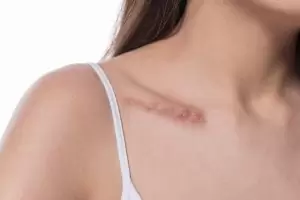 When you injure your skin, your body naturally repairs the damage. How your body repairs this damage depends on how deeply the injury penetrates your skin.
When you injure your skin, your body naturally repairs the damage. How your body repairs this damage depends on how deeply the injury penetrates your skin.
A scar is the body’s natural way of healing and replacing lost or damaged skin. Scarring may be significantly improved through laser treatments, injections, surgery, and dermabrasion.
One of the most frequent reasons our patients come for consultation is for the treatment of scars due to surgery, injuries, acne or infections. Broadly speaking, there are three ways of treating scars: topical products, surgical revisions or laser treatments. Each of these has its own risks and benefits and is associated with its own degrees of success.
Scarring is an unfortunate part of life. Whether from acne, chicken pox, surgery or trauma, the damage that a scar causes is life-long and can be profound.
Fortunately, with the advance of new treatments there is hope for all patients to see their scars decrease in size and in some cases even disappear completely.
Frequently Asked Questions
What causes scars?
Scars can result from accidents, diseases, skin conditions such as acne, or surgeries.
How do scars form?
Scars form when the dermis (the deep, thick layer of skin) is damaged. The body forms new collagen (a naturally occurring protein in the body) fibers to mend the damage, resulting in a scar. The new scar tissue will have a different texture and quality than the surrounding tissue. Scars form after a wound is completely healed.
What are the different kinds of scars?
Most scars are flat and pale. However, in cases when the body produces too much collagen, scars can be raised (i.e., higher than the surrounding skin). Raised scars are called hypertrophic scars or keloid scars. Both of these kinds of scars are more common in younger and dark-skinned people.
Some scars can have a sunken or pitted appearance. This kind of scarring occurs when underlying structures supporting the skin (i.e., fat or muscle) are lost. Some surgical scars have this appearance, as do some scars from acne.
Scars also can appear as stretched skin. Such scars result when the skin stretches rapidly (i.e., as in growth spurts or during pregnancy). In addition, this type of scar can occur when the skin is under tension (near a joint, for example) during the healing process.
We Can Help You
Call us to schedule your appointment today at (212) 673-5633 or visit us at one of our conveniently located New York offices to learn more about our extensive line of cosmetic dermatology procedures and how they could transform your appearance.

